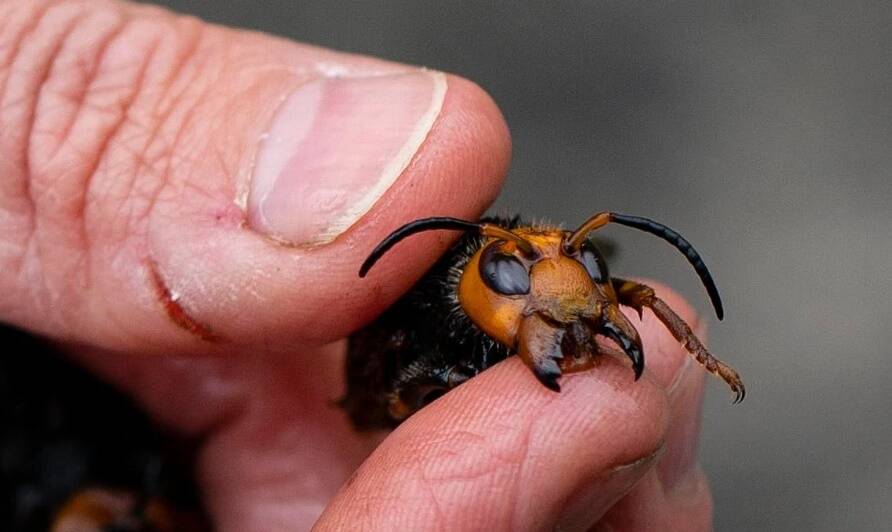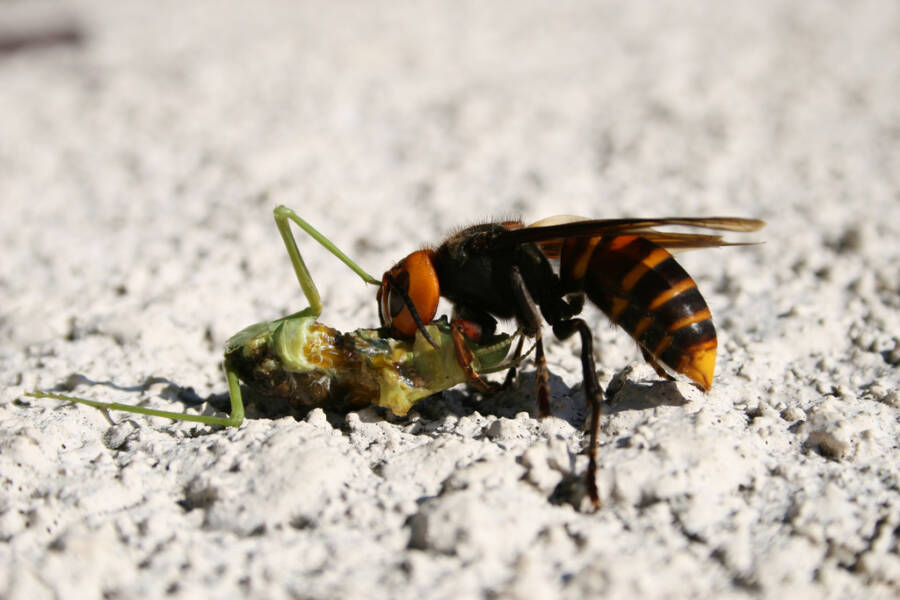The earliest sighting was in the fall of 2019 when two of the insects were uncovered in Washington State.

Ruth Fremson/The New York TimesClose-up of a dead murder hornet with the sharp mandibles it uses to decapitate bees.
Sightings of an invasive species of hornet known as “murder hornets” — a nickname derived from their vicious stings and slaughter of honey bees — have prompted fears that the insects could have a catastrophic effect on the environment in the U.S.
According to the New York Times, multiple populations of the Asian giant hornet have been discovered in the U.S. and Canada for the first time.
Asian giant hornets are from East Asia. They are distinct due to their enormous size — their queens can grow up to two inches long. They have sharp mandibles and stingers, and the ability to fly up to 15 miles per hour.
In Japan alone, the hornets kill up to 50 people a year. But their capabilities show through their gruesome slaughter of honey bees.
These giant hornets destroy bee colonies, first decapitating the bees, then ripping off their thoraxes and feeding them to their young. These giant bugs have earned the title ‘murder hornets’ from entomologists.

Ted McFall/The New York TimesThe dead members of the Ted McFall’s bee colony that was likely ravaged by a murder hornet.
Now, these aggressive bee killers have made their way to the U.S. The earliest sighting was in the fall of 2019 when two of the insects were uncovered in the northwest corner of Washington State.
“I couldn’t wrap my head around what could have done that,” beekeeper Ted McFall said of the grisly scene of decapitated bees he found at one of his hives in Washington. But based on the carnage left behind, he suspected the culprit was a murder hornet.
Confirmation of the insect’s presence in the U.S. came following a discovery by Jeff Kornelis, who lives two miles from McFall. Upon finding a giant dead hornet on his property, Kornelis contacted the state which later confirmed the insect was an Asian giant hornet.
Around the same time, confirmed cases across the border in Vancouver, Canada, came to light.
Conrad Bérubé, an entomologist in Nanaimo, was stung by a group of the killer hornets after he tried to exterminate their hive on Vancouver Island. He suffered multiple stings that penetrated his thick beekeeper suit and inner-layer of sweatpants.
“It was like having red-hot thumbtacks being driven into my flesh,” Bérubé recalled. Some of the stings drew blood and even caused him to suffer aches throughout his legs. It was by far the worst experience he had suffered through his career, Bérubé said. But his actions led to the confirmation of the species in Canada.
According to Jun-ichi Takahashi, a researcher at Kyoto Sangyo University in Japan, aggressive group attacks from the species have been known to expose victims to doses of toxic venom comparable to that of a venomous snake.

Wikimedia CommonsAn Asian giant hornet feeding on a mantis. These insects are both venomous and aggressive.
It soon became clear the murder hornets had arrived in North America. Through a partnership between agriculture biologists and local beekeepers, Washington state launched a hunt for the giant hornets’ nests, setting traps filled with sweet orange juice, kefir, and other lures to entice the insects out.
Launched over the 2019 winter season, efforts to eradicate the giant hornets continue as scientists worry the insects could decimate the U.S. bee populations if not quickly addressed.
Scientists involved in the hunt have employed high-tech tools such as thermal tracking in the hopes they can identify the hives amid the state’s cold damp woodlands.
According to Chris Looney, an entomologist at the Washington State Department of Agriculture, researchers also plan to implement radio-frequency identification tags on captured hornets which may lead to its nest.
“This is our window to keep it from establishing,” Looney told the Times. “If we can’t do it in the next couple of years, it probably can’t be done.”
Unfortunately, these killer bugs continue to roam the west coast and — if not dealt with adequately — may soon make their way to other parts of the country.
Next, read about the largest bee species rediscovered in Indonesia after it was thought extinct and learn how an unknown crusader in Texas killed 600,000 bees by setting their hives on fire.





